InstructionsCookie Business Final Presentation Now that you have completed running some calculations for the cookie business in Unit VII, you will present your findings.The learning objectives of this project allow you to apply accounting concepts and standards to the creation of accounting information and reports. Using your final project from Unit VII as a guide, create an eight- to ten-slide PowerPoint presentation. In this presentation, you want to summarize what you found and discuss how you think these findings will help you make better business decisions. In addition, provide future recommendations for the cookie business based on your report findings. Your presentation slides should be somewhat simple (incomplete sentences, bullets, etc.) with appropriate graphics or images. You must add content to your presentation (completed sentences) through either the notes feature in PowerPoint or by creating a video of you presenting your presentation, uploading your video to YouTube, and sharing the link to your video on the first or second slide of your presentation. The following resources will help you with your presentation: PowerPoint Basics (This will show you how to add notes to your presentation.) YouTube Upload Instructions Be sure to use APA formatting throughout, and reach out to the Writing Center or the CSU Online Library for assistance with research, writing, and formatting. Include at least two resources from the CSU Online Library in your report.
Instructions Cookie Business Final Presentation Now that you have completed running some calculations for the cookie business in Unit VII, you will present your findings.The learning objectives of th
1
Cookie Creations Final
Brandon Green
Columbia Southern University
ACC 5301 Management Applications of Accounting
Professor McHugh
December 22, 2021
Abstract
This paper is an overview of the case, Cookie Creations, compiling the financial status as well as the general outlook of the firm. When considering the per unit contribution of all the products and services offered by the firm, it was established that only specialty cookies and chocolate chips were more profitable for the firm. It is important to establish whether cutting the production of some of the products would be a prudent idea. For Cookie Creations, the absorption costing seemed to be the more effective option as the preferred method is the Generally Accepted Accounting Principles (GAAP) (El-Gazzar & Finn, 2017). Furthermore, ethics should guide the operations of the firm. Focusing on improving the firm’s efficiency should be core for Cookie Creations in order to mitigate wastage of scarce resources such as labor while procuring materials that are less expensive.
Cookie Creations Final
Cookie Creations is a startup business that was established by two friends who had a single vision of making health-conscious dessert cookies to meet the needs of the consumers. Initially, Cookie Creations intended to offer just a single flavor to the consumers. The flavor in mind was to be plant-based and had to possess high protein value, with no preservatives. After the initial offer was considered to be successful, Cookie Creations is seeking to expand its operations. This saw the inclusion of sugar cookies, healthy chocolates, as well as specialty cookies. Its mission is to ensure that the best and most healthy cookies were made using the healthiest ingredients using ethical practices. The purpose of this discussion paper will be to present some of the accounting tables such as the contribution margin, full and variable costing, special order, internal rate of return, cash receipts, as well as material and labor variances.
Part 1 Contribution Margin/Breakeven
Figure 1: Contribution Margin
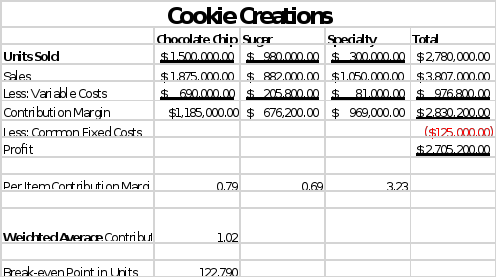
From Figure 1 above, the chocolate chip cookies seemed to be the best-selling cookie among the three types of cookies offered. This was followed by the sugar cookie and the specialty cookie. However, the specialty cookie had the highest per-item contribution of 3.23, which was almost 4.7 times better than the sugar cookie. Rojas (2019) recommends discontinuing the production of some products in order to make money and produce a positive contribution margin. In this, the firm could choose to discontinue the production of the sugar cookie that had the least per item contribution margin. The resources that were being used to produce the sugar cookies, such as the machinery and labor, could be used to further improve the production of specialty cookies. This could translate to a breakeven point of 122,790 units.
Part 2 Full and Variable Costing
Absorption costing includes all costs that will be incurred in the production of the cookies, including the overhead costs, while variable costing includes only the variable costs disregarding fixed costs (Gersil & Kayal, 2016). Therefore, absorption costing allows the firm to understand the full costs. When using the absorption costing, the cost per unit will be $2.05 with a variable costing rate of $2.00 per unit. This is illustrated in Figure 2 below. Cookie Creations should consider the absorption costing method as it is the preferred costing method for use by the GAAP in the United States. Therefore, Cookie Creations should use this costing method as the firm is based in the United States.
Additionally, the ending inventory from using the absorption costing method would be $369,000 while the variable costing method would be $360,000. This means that the firm would benefit more from implementing the full absorption costing method than it would from the variable costing method.
Figure 2: Full and Variable Costing

Part 3 Special Order
Figure 3: Special Order
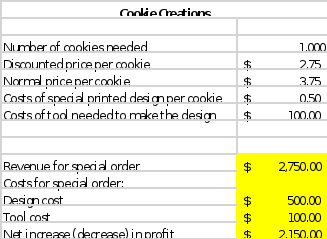
Because of the reduced business activities over the last few months, the offer to make specialty cookies at a discount is a decision that has its own effects on the business. First of all, making the cookies for the wedding ceremony will see a loss of $1 per cookie compared to the normal pricing of the cookies, down to $2.75 per cookie from $3.75 per cookie. The cookies would also require design costs of $500 ($0.5 per cookie) and $100 for the tool used for designing the specialty cookies. The total revenue incurred would be $2.75*1,000=$2,750 while the expenses would amount to $600. This means that the business would be left with a profit increase amounting to $2,150. This would be good profitability considering the fact that the business would re-use the designing tool for future specialty orders, and thus act as an additional asset for the firm. The firm should thus accept the offer when the business is slow to increase its profitability and cover expenses, bills, and wages for the employees.
Part 4 Internal Rate of Return
Figure 4: Internal Rate of Return
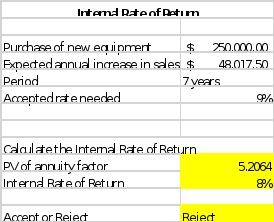
The results for the internal rate of return (IRR) indicated that over the seven-year period, the accepted rate needed was 9%. However, the firm was able to attain an internal rate of change of 8 percent and a PV annuity factor of 5.2064. this implies that Cookie Creations should reject the purchase of new equipment because it was below the accepted rate of 9 percent.
Furthermore, it should be understood that favoritism from family members, relatives, or other parties is a violation of the code of ethics. Therefore, making of the decision of whether or not to purchase new equipment should be based on the financial status of the firm and not solely on relationships with the other partners.
Part 5 Cash Budget
Figure 5: Cash Budget
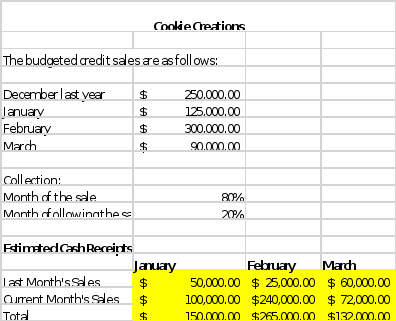
In order to cover all the expenses, the firm needed $150,000 every month. Since sales for any firm could fluctuate from time to time, a firm could make profits, losses, or breakeven. In January, Cookie Creations broke even because it had receipts worth $150,000 and the expenses were worth just $150,000. In February, the firm made a profit worth $115,000 ($265,000 in receipts – $150,000 for expenses) while in March, the firm incurred a loss of $18,000 ($132,000 for receipts – $150,000 for expenses). Therefore, the surplus funds in some of the months could be used to cover for the months where the firm incurred a loss, such as in March.
Part 6 Material and Labor Variance
Figure 6: Material and Labor Variance
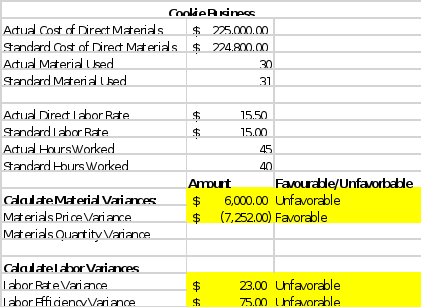
Cookie Creations used less material than expected. However, the firm ended up paying up a higher amount of direct materials than the firm had anticipated. Similarly, the labor rate and efficiency were also unfavorable. The firm should thus strive to make the necessary adjustments. For instance, the firm could either improve labor efficiency or procure less expensive raw materials. This could help to lower the high costs of raw materials and labor.
Conclusions and Recommendations
Cookie Creations is a company that is fast growing. Achieving profitability will help the firm to not only remain competitive but also manage to achieve sustainability. Generally, the specialty cookie and the chocolate chip were the more profitable items based on the per-item contribution margin. The firm should thus cross-examine to identify if cutting the production of the sugar cookies had grounds or whether the move was unwarranted. Since the firm was based in the United States, it would be recommendable if the absorption costing method was used as it is most suitable for use under the GAAP and considers all potential costs to come up with a clearer manner. When the business is slowed down, it is recommended that the business takes up on some special orders during special occasions. This will allow the firm to make some profits that could help pay bills, pay employees, and keep the firm operational rather than closing when the business has slowed down. Furthermore, the firm should consider a code of ethics and the financial status of the firm to be the guiding principle when determining the rationality of the decisions about to be made. Cash reserves could be used to offset negative cash flows that may happen during some of the months. This could also play a vital role in improving the labor rate and efficiency of the firm.
References
El-Gazzar, S. M., & Finn, P. M. (2017). Restatements and accounting quality: a comparison between IFRS and US-GAAP. Journal of Financial Reporting and Accounting.
Gersil, A., & Kayal, C. (2016). A Comparative Analysis of Normal Costing Method with Full Costing and Variable Costing in Internal Reporting. International journal of management, 7(3).
Rojas, F. (2019). Optimal contribution margin in foodservice using inventory control with statistical dependence. Ingeniare: Revista Chilena de Ingenieria, 27(1), 89-100.






